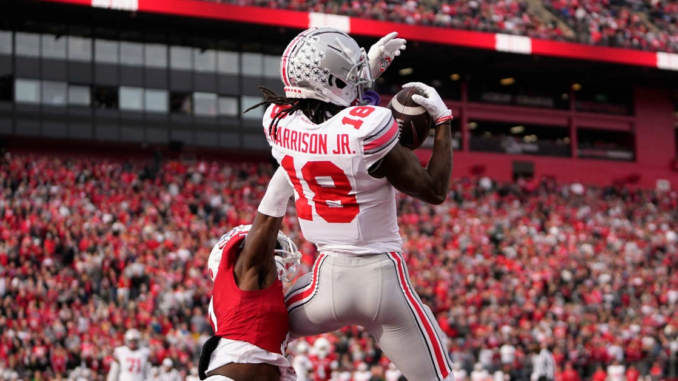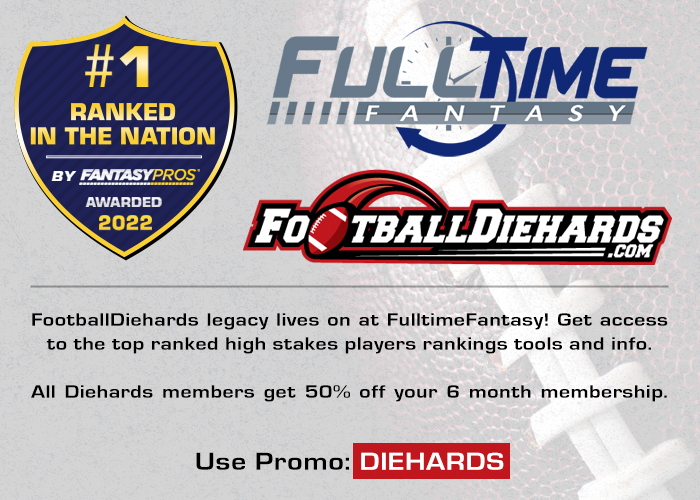
Introduction to Dynasty Fantasy Football
Fantasy football has exploded over the past several years. Even some of the most diehard managers still have not heard about dynasty fantasy football. If you have that itch in March, April, or even May to “tinker” with a lineup or make a trade, then you have come to the right place and a dynasty league is just the thing for you.
The goal here is to give you an essential road map for navigating your first-ever dynasty startup draft and all the nuances involved, which you do not necessarily deal with in redraft leagues.
FullTime Fantasy has you covered with the latest dynasty football rankings. Also, check out these great dynasty league start-up tips. Finally, don’t miss out on your chance to win the Dynasty Football World Championship.
What is a Dynasty League?
We will start by defining a dynasty league courtesy of the industry leader in the format DLF (Dynasty League Football). In a dynasty fantasy football league, you retain most or all of your players yearly. This creates an environment quite different from that of a redraft league. It also creates a stronger sense of team pride, enabling managers to keep players and build a team over time. Success is achieved with greater satisfaction.
Mistakes or successes in a dynasty league can affect a franchise’s fortunes for years, just like in the NFL. A dynasty league also facilitates trades, including trading draft picks, and encourages a deeper roster pool so young “project” players can be identified and groomed.
Read the Fine Print
Familiarize yourself with the rules and settings of your leagues just as you would in redraft. Pay extra special attention to roster sizes, IR (injured reserve) slots, whether or not your league allows taxi squads, and whether or not there are any types of contracts or salaries involved. For beginners, we recommend a more simplified league that does not utilize contracts and salaries.
Your draft strategy will change depending on whether the league is non-PPR, half-PPR, or full-PPR. You will also be severely pivoting if it is a Superflex (two-quarterback league) or tight end premium (tight ends scoring weighed heavier) because values change dramatically based on the starting lineup allocations and scoring format.
Timely Drafting
We can understand the urge to draft immediately once you decide to plunge into the dynasty format, but the prudent approach is to wait until peak redraft season. This will allow you to acquire as much information as possible to make educated and informed decisions. This will be beneficial not only to you but also to other managers who may be new to the dynasty format. Next season, you can have your rookie draft right after the NFL draft to feed that craving you are experiencing in the offseason.
Be Active Early and Often
While you want to be careful not to mortgage the future too much, a good strategy involves acquiring more picks in the first five or six rounds, if possible. This allows you to draft several sure-fire starters for the current and next several seasons if you have done your due diligence.
Ensure your contact information is current and you reply to messages or inquiries about potential trades. Interact with other managers and keep communication moving in a positive direction. This will benefit you in the long term in your dealings with others.
Remember, you are joining a dynasty league to feed your addiction, which is now year-round. This is not to say that you must log on to your league site daily, but do check back often. You will learn quickly that values change rapidly in this format, and you need to be keen on capitalizing on the current market.
Something else to consider, which is very important, is the reliability of the other managers in the league you join. You want others who are as committed as you and will stick with the league through the good and bad times. Like in your redraft league, there is only one champion, meaning there are 11 (or nine, depending on your league size) other losers. The ability to “reset” your team after a bad season does not exist in a dynasty league.
Know Your Values
Long gone are the days of just using cheat sheets. There are so many more tools at your disposal now. One of the most important in determining the value of dynasty players is ADP (average draft position). Ryan McDowell organizes ADP data from mock drafts of the Startup Dynasty. It is then published on DLF (Dynasty League Football) for consumption.
By using ADP instead of rankings, you remove the opinion of just one expert or panel of experts and incorporate the community as a whole, along with the experts, to gather a consensus value of a particular player. Even more important is that these are broken down by league type (one quarterback or Superflex).
The other keyword here is current. DLF updates ADP monthly, so you will have the most recent player valuation to work with during your start-up draft.
The last thing to touch on concerning value is the ability to determine what future rookie picks are worth. You will want to determine if other managers overvalue future picks. Try to put a name to the picks involved in the deal to give you the proper framework for the deal.
For example, you want to trade for a sixth- or seventh-round pick in your current startup draft. Approximate what player you would target in that range, and then carefully calculate who would be available in the rookie draft next year based on the multitude of prospect rankings available.
Stick to Your Guns
Do not fall into the trap of filling out your lineup a certain way. Doing so causes you to stray from the BPA (best player available) approach and ultimately leads to reaching for a player to fill a spot, thus decreasing the value of the slot you are drafting from.
Leagues have been trending towards starting more flex positions lately, but most still require at least two running backs and two wide receivers. Do not take a running back just because you feel you “need” one, only to pass up on a wideout who has more value.
Roster Construction
You may ask what your roster should look like in a dynasty league. The answer depends on your league settings. If it is a one-quarterback league, you must have a top-10 quarterback on your roster and do not need to worry about their backup. You can have another starter on your roster and have them sit there until the bye week arrives or if your top quarterback suffers an unfortunate injury.
In two-quarterback leagues, this changes quite a bit. You will not necessarily have the luxury of a quality starter to back up one of your two starting signal-callers. You will want to try to acquire at least three starting-caliber players since you will have two bye weeks and account for potential injuries.
The running back landscape has also changed over the years, and most teams now employ an RBBC (running back by committee) approach and do not have a true “workhorse” back that they lean on. Outside of the top four or five drafted running backs, there are questions about usage across the board. This forces us to set aside more bench spots for the position than perhaps we would like.
The good news is that the wideout position is as deep as ever in a passing league. We have several steady producers to choose from here and can lock and load this spot most weeks, allowing us to save room on the pine for the rushers mentioned above.
Finally, we have the tight end position. Much like the running back spot, this position is currently top-heavy. If possible, you will want to try to draft one of the top three or four tight ends. If you cannot secure one of them, you will want to roster several younger, high-upside players in good situations to fill out your bench.
Most dynasty leagues (and redraft leagues, for that matter) have eliminated kickers and defenses because of their volatility. If the league you are joining decides to use them again, wait for them. Do not invest draft capital on positions that fluctuate so much from season to season and can be “streamed” based on matchups.
If your league uses them but does not require you to draft one, don’t. Select young players with upside and wait until you are required to submit a lineup before cutting bait on the back of the bench player.
Trading
This is what fuels the dynasty fire. If you do not like trading, then this is not for you. Every trade impacts your team for more than just the current season, no matter how big or small. When drafting and building your roster, you will also want to ask yourself how valuable each player is. Will there be a demand for them? If you do not believe there will be, pivot and select a player in the same range to get trade talks flowing.
Be astute about whether another manager is in a rebuild or “win now” mode. This will determine how active they are in trading during the season and how willing they are to overpay for assets that may carry them to the title this season. Do not feel like you always have to “win” a trade, or deals will never get done. Like redraft, you aim to acquire the best player in the deal and get the guys you want. You may have to add extra spice to the deal to get it across the finish line.
Wrapping it All Up
If you read this far, welcome to the club! We are glad to have you. The dynasty community is welcoming, and there are a plethora of resources at your disposal to help you become a better manager. One of the best resources is the DLF Forum, where you can ask and answer questions for FREE!
From there, it becomes a choose-your-own-adventure. You can mix in IDP (Individual Defensive Players), contracts, salaries, salary caps, devy players, auctions, and several other features that make your league slightly less vanilla than your average redraft league. Enjoy your journey, wherever it may take you.



